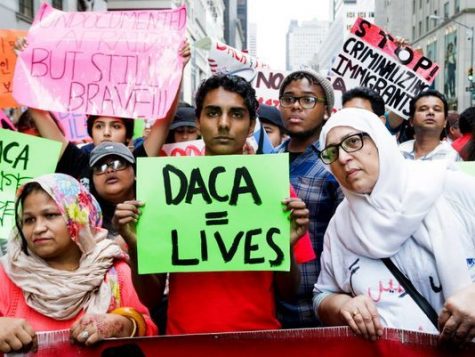Seniors eager to graduate before semester conversion
November 1, 2017
On Sept. 5, President Trump and his administration announced the end of Deferred Action for Childhood Arrivals. DACA, which was approved by U.S. Citizenship and Immigration Services (USCIS), allowed approximately 800,000 undocumented youth to receive a work permit and be protected from deportation. However, beginning Oct. 5, they will no longer be accepting renewals.
DACA was established by the Obama Administration in June 2012 as a result of ongoing pressure from “Dreamers” or undocumented immigrants who wanted to legally enroll in school and work in the United States without fear of deportation. President Donald Trump, who called DACA, “illegal amnesty,” decided to terminate the policy and ask Congress to come up with a better option that is “fair for everyone.”
“I will not let that stop me from providing for my daughter,” Brenda Torres, a DACA enrollee, told The Pioneer. Torres, a single mom of a 4 year-old daughter, took full advantage of DACA and went to school at San Jose City College, earned a degree and is now working as a dental assistant. “I will find an alternative till the Government finds a solution.”
Christian Aguilar, another DACA enrollee and student at San Jose State University, pays SJSU in-state tuition, which is about $7,316 a year compared to out-of-state tuition at $18,476 a year. “Well, I am happy I get to stay in school, for now, but it sucks that I will now have to pay out-of-state tuition.”
Torres and Aguilar are among 690,000 young undocumented students enrolled and protected by DACA. They are both rushing to find an alternative to avoid putting their lives on hold. Many DACA recipients are seeking professional immigration help from attorneys to learn about their alternatives.
According to the USCIS, after President Donald Trump and his administration announced the termination of DACA on Sept. 5, 70,000 enrollees did not renew or were denied their renewal by the Department of Homeland Security due to Oct. 5 deadline having passed. Another 40,000 applied for visas or married a U.S. citizen to obtain a green card.
Based on data the USCIS have posted on their website, DACA enrollees have boosted the U.S. economy within the five years since it was validated in August 2012, by opening bank accounts and purchasing cars and homes.
President Trump and Congress have agreed not to completely dismantle the DACA idea and hope to find a solution for Dreamers protected by the policy. On Sept. 25, Republican Senator Thom Tillis for North Carolina introduced the SUCCEED Act (Solution for Undocumented Children through Careers Employment Education and Defending our nation) during a news conference in Washington D.C.
SUCCEED will be the replacement for DACA. The requirements are similar and it promises enrollees that they can apply for a green card and start the naturalization process. SUCCEED gives applicants five years of employment opportunity at a time and protection from deportation.
“If you work hard, follow the law and pay your taxes, you can stay here permanently,” said Senator Tillis to reporters in Washington D.C. on Sept. 25.
Senator Tillis also informed reporters that after ten years enrolled in SUCCEED, applicants can apply for a green card. Requirements for applicants of SUCCEED are to seek higher education and get a degree or enroll to serve in the military.
Other requirements ask for applicants to have arrived to the U.S. before the age of 16 with a high school diploma or equivalent, passed a background check that includes no debt or criminal record and submitted personal info to the Department of Homeland Security.
Republican senator for Utah, Orrin Hatch, added to Tillis’ Washington DC speech, “We have millions of great young people that can add a great deal to our country.”





















